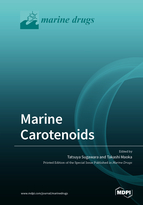Marine Carotenoids
A special issue of Marine Drugs (ISSN 1660-3397).
Deadline for manuscript submissions: closed (31 July 2021) | Viewed by 180612
Special Issue Editors
Interests: analysis and structural elucidation of carotenoids; chemistry of carotenoids; chemosystematics and chemical ecology of carotenoids
Special Issues, Collections and Topics in MDPI journals
Interests: molecular nutrition of marine carotenoids; marine lipid chemistry; molecular design of functional lipids
Special Issues, Collections and Topics in MDPI journals
Keywords
- marine carotenoids
- distribution
- biosynthesis
- absorption
- metabolism
- bioavailability
- antioxidant activity
- anti-cancer
- prevention of cardiovascular disease
- anti-atherosclerosis
- anti-obesity
- anti-diabetes
- anti-inflammatory
Related Special Issue
- Marine Carotenoids (Special Issue) in Marine Drugs (21 articles)







